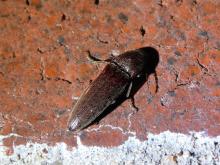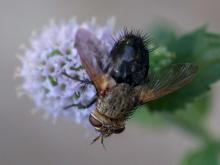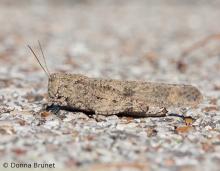Land Invertebrates
Media

Species Types
Scientific Name
More than 400 species in North America north of Mexico
Description
The name is a warning: blister beetles are famous for their chemical defenses. Beetles in this family can exude an oil that can cause a person’s skin to blister.
Media

Species Types
Scientific Name
Approximately 1,000 species in North America
Description
Their streamlined shape is distinctive, but the behavior of click beetles is even more unique: Placed on their backs, these beetles flip suddenly into the air with an audible click.
Media

Species Types
Scientific Name
About 1,300 species in North America north of Mexico
Description
The longlegged flies are a large, diverse fly family. They often have eye-catching metallic green, copper, bronze, or blue bodies and long legs. Their delicate wings are often clear and look iridescent in bright light, but many species have dark marks near the wing tips.
Media

Species Types
Scientific Name
Neoscona crucifera
Description
A widespread species, the barn spider commonly builds its webs in woods and on the eaves of barns, houses, and similar structures.
Media

Species Types
Scientific Name
About 1,350 species in North America north of Mexico
Description
Tachinid flies are one of the largest families of flies. They are parasitic flies whose larvae are parasitoids of other insects. They look a lot like house flies, blow or bottle flies, wasps, or bees. Many are very bristly.
Media

Species Types
Scientific Name
Lygaeus kalmii
Description
The small milkweed bug is one common type of seed bug. It is found on many more plants than just milkweeds.
Media

Species Types
Scientific Name
Dissosteira carolina
Description
The Carolina grasshopper is frequently seen in dusty, open habitats like dirt roads and vacant lots. Its yellow-bordered, black hindwings make it look like a mourning cloak butterfly.
Media

Species Types
Scientific Name
More than 1,200 species in North America north of Mexico
Description
Andrenid bees, also called mining bees, are solitary ground-nesters. Most are specialist pollinators whose life cycle is timed to correspond precisely to the blooming of specific flowers.
Media

Species Types
Scientific Name
About 1,000 species in North America north of Mexico
Description
Many apid bees are well-known. This family includes the familiar honeybee, bumblebees, and carpenter bees, plus many that are less well-known. With few exceptions, most of Missouri's apid bees are native, solitary species.
Media

Species Types
Scientific Name
Araneus marmoreus
Description
The marbled orbweaver is sometimes called the “pumpkin spider” because its rounded abdomen is sometimes bright orange. The color and markings can vary greatly.
See Also



Media

Species Types
Scientific Name
Cisseps fulvicollis
Description
The yellow-collared scape moth is more often “orange-collared.” And whether you think it looks more like a firefly or a wasp, it’s still a moth!
Media

Species Types
Scientific Name
Nearly 150 species in North America north of Mexico
Description
Slim, delicate plume moths are instantly recognizable by their T-shaped silhouette, long legs, and muted shades of tan and brown. It can be hard to separate the various species.
Media

Species Types
Scientific Name
Pyrrharctia isabella
Description
Not many people know the adult Isabella tiger moth when they see one, but we’re all acquainted with its caterpillar, the woolly worm, or woolly bear.
About Land Invertebrates in Missouri
Invertebrates are animals without backbones, including earthworms, slugs, snails, and arthropods. Arthropods—invertebrates with “jointed legs” — are a group of invertebrates that includes crayfish, shrimp, millipedes, centipedes, mites, spiders, and insects. There may be as many as 10 million species of insects alive on earth today, and they probably constitute more than 90 percent all animal species.





















